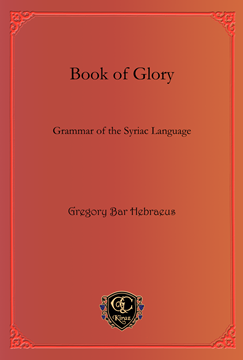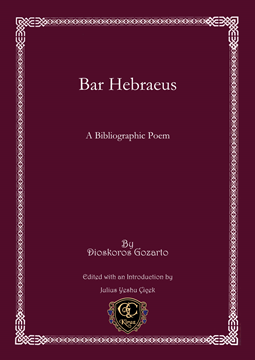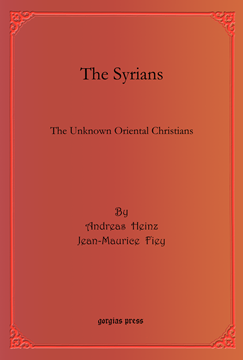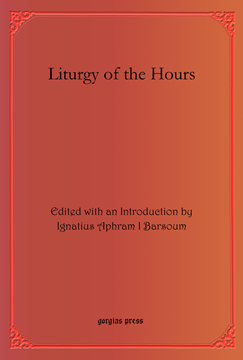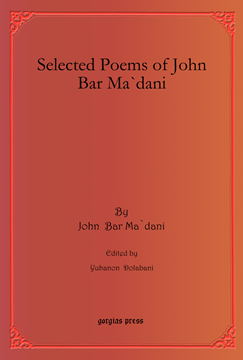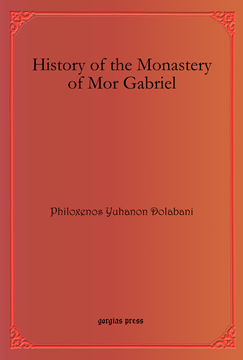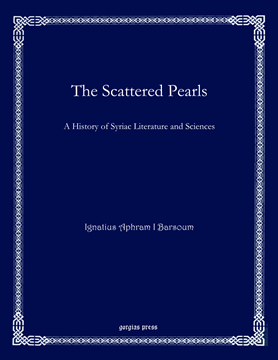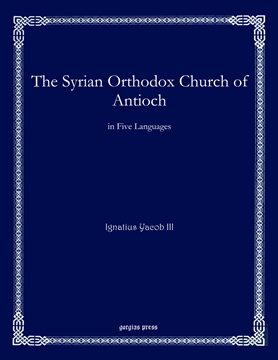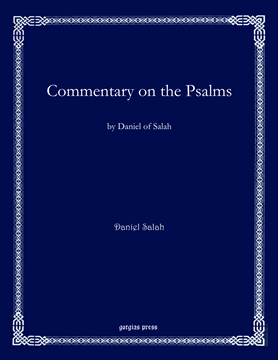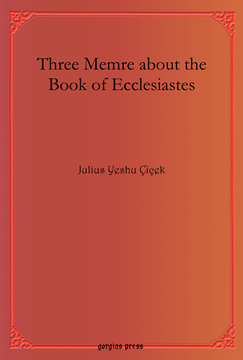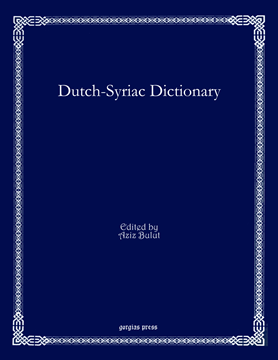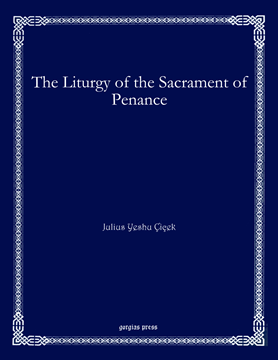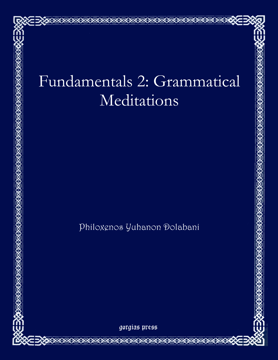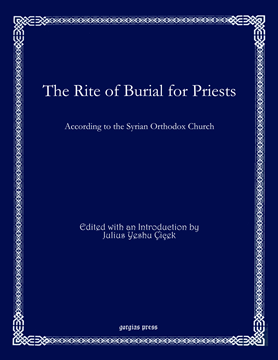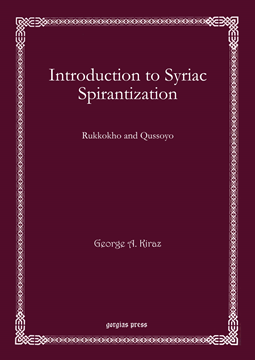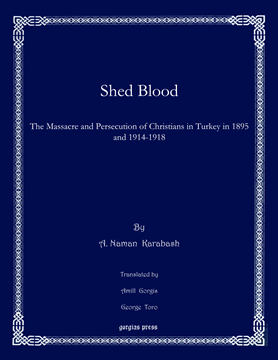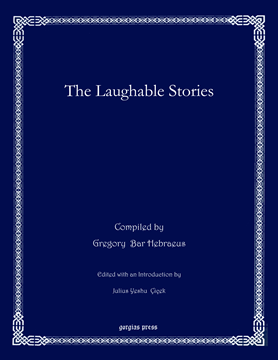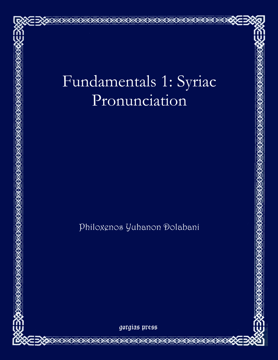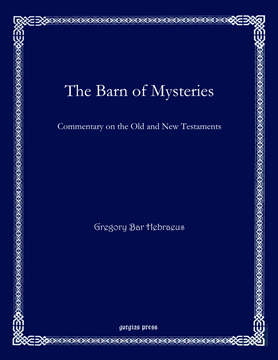Bar Ebroyo Kloster Publications
Book of Glory
Grammar of the Syriac Language
Series: Bar Ebroyo Kloster Publications 5
ISBN: 978-1-61143-199-5
Gregory Bar Hebraeus, most well known for his historical works, also produced a grammar of the Syriac language. The present volume presents his grammar typed in Serto font and accompanied by Latin chapter headings.
$150.00 (USD) $90.00 (USD)
Ethicon
Christian Ethics
Series: Bar Ebroyo Kloster Publications 38
ISBN: 978-1-61143-232-9
Gregory Bar Hebraeus, one of the most important authors of the later Syriac tradition, presents here a systematic book of ethics for the Christian life.
$186.00 (USD) $111.60 (USD)
Bar Hebraeus
A Bibliographic Poem
By Dioskoros Gozarto; Edited with an Introduction by Julius Yeshu Çiçek
Series: Bar Ebroyo Kloster Publications 41
ISBN: 978-1-61143-235-0
The present volume includes a poetic bibliographic narrative about Gregory Bar Hebraeus, the thirteenth century Syriac author whose various works are among the most important of the later Syriac tradition.
$153.00 (USD) $91.80 (USD)
The Syrians
The Unknown Oriental Christians
Series: Bar Ebroyo Kloster Publications 48
ISBN: 978-1-61143-242-8
Syriac Christianity is largely unfamiliar among Christians of the Western traditions. The present volume seeks to rectify this unfamiliarity by providing two brief introductory essays to the Syriac traditions.
$150.00 (USD) $90.00 (USD)
Liturgy of the Hours
Edited with an Introduction by Ignatius Aphram I Barsoum
Series: Bar Ebroyo Kloster Publications 46
ISBN: 978-1-61143-240-4
This volume presents the liturgies and prayers for the weekly practice of the divine hours according to the rite of the Syrian Orthodox Church of Antioch.
$185.00 (USD) $111.00 (USD)
Selected Poems of John Bar Ma`dani
By John Bar Ma`dani; Edited by Yuhanon Dolabani
Series: Bar Ebroyo Kloster Publications 32
ISBN: 978-1-61143-226-8
This volume includes four poems by John Bar Ma`dani (d. 1263), former Patriarch of Antioch.
$108.00 (USD) $64.80 (USD)
History of the Monastery of Mor Gabriel
Series: Bar Ebroyo Kloster Publications 26
ISBN: 978-1-61143-220-6
Philoxenos Yuhanon Dolabani provides a history of the monastery of Mor Gabriel, the oldest surviving monastery of the Syrian Orthodox tradition.
$128.00 (USD) $76.80 (USD)
Poems about Sayfo
What Happened to Christians in Turkey from 1714-1914
Edited by Julius Yeshu Çiçek
Series: Bar Ebroyo Kloster Publications 25
ISBN: 978-1-61143-219-0
The present volume is a collection of poems about the suffering of the Christians in Turkey leading up to the massacre of 1915.
$126.00 (USD) $75.60 (USD)
The Syrian Orthodox Church of Antioch
A Historical Overview
By Hanna Aydin
Series: Bar Ebroyo Kloster Publications 35
ISBN: 978-1-61143-229-9
In the present volume, Hanna Aydin offers a history of the Syrian Orthodox Church of Antioch from its beginning to the late twentieth century.
$168.00 (USD) $100.80 (USD)
The Scattered Pearls
A History of Syriac Literature and Sciences
Series: Bar Ebroyo Kloster Publications 33
ISBN: 978-1-61143-227-5
Mor Ignatius Aphram I Barsoum presents a comprehensive history of the literature of the Syriac tradition.
$226.00 (USD) $135.60 (USD)
The Syrian Orthodox Church of Antioch
in Five Languages
Series: Bar Ebroyo Kloster Publications 24
ISBN: 978-1-61143-218-3
The present work is a brief essay that provides a basic introduction to the Syrian Orthodox Church. This volume includes the essay in five languages: Arabic, German, Dutch, Turkish, and English.
$120.00 (USD) $72.00 (USD)
Commentary on the Psalms
By Daniel Salah
Series: Bar Ebroyo Kloster Publications 51
ISBN: 978-1-61143-245-9
Daniel of Salah’s Commentary on the Psalms was one of the foundational exegetical and theological works of the developing Syriac miaphysite tradition. The present volume presents the Syriac text of Daniel’s commentary in vocalized Serto script.
$214.00 (USD) $128.40 (USD)
Three Memre about the Book of Ecclesiastes
Series: Bar Ebroyo Kloster Publications 27
ISBN: 978-1-61143-221-3
This volume includes three metrical memre about the book of Ecclesiastes, each written by three authors: Eprhem the Syrian, Jacob of Serug, and John of Mosul.
$107.00 (USD) $64.20 (USD)
Rite of the Eucharist
Pocket-size Edition
Edited by Ignatius Zakka I Iwas
Series: Bar Ebroyo Kloster Publications 45
ISBN: 978-1-61143-239-8
This volume contains the liturgical rite for the Eucharist according to the order of the Syriac Orthodox Church of Antioch.
$108.00 (USD) $64.80 (USD)
Dutch-Syriac Dictionary
Edited by Aziz Bulut
Series: Bar Ebroyo Kloster Publications 40
ISBN: 978-1-61143-234-3
The present work is a Dutch-Syriac dictionary with separate sections for Syriac to Dutch and Dutch to Syriac.
$273.00 (USD) $163.80 (USD)
The Liturgy of the Sacrament of Penance
Series: Bar Ebroyo Kloster Publications 9
ISBN: 978-1-61143-203-9
The present volume contains the text of the rite for the liturgy of penance, one of the sacraments of the Syriac Orthodox Church of Antioch.
$109.00 (USD) $65.40 (USD)
Fundamentals 2
Grammatical Meditations
Series: Bar Ebroyo Kloster Publications 3
ISBN: 978-1-61143-197-1
In volume 2 of his Syriac Grammar, Mor Philoxenos Yuhanon Dolbani introduces grammatical concepts for more advanced students. The book is organized into brief chapters that introduce new concepts, and each chapter includes questions and exercises.
$118.00 (USD) $70.80 (USD)
The Rite of Burial for Priests
According to the Syrian Orthodox Church
Edited with an Introduction by Julius Yeshu Çiçek
Series: Bar Ebroyo Kloster Publications 53
ISBN: 978-1-61143-247-3
The present volume contains the text of the liturgical rite for the burial of priests in the Syrian Orthodox Church.
$117.00 (USD) $70.20 (USD)
Introduction to Syriac Spirantization
Rukkokho and Qussoyo
Series: Bar Ebroyo Kloster Publications 50
ISBN: 978-1-61143-244-2
This volume includes a basic introduction to the rules of Syriac spirantization in three languages: Arabic, Syriac and English.
$164.00 (USD) $98.40 (USD)
Shed Blood
The Massacre and Persecution of Christians in Turkey in 1895 and 1914-1918
Series: Bar Ebroyo Kloster Publications 49
ISBN: 978-1-61143-243-5
The first hand account of the atrocities suffered by the Christians of Tur Abdin from 1914-1918 by A. Naman Karabash and translated into German by George Toro and Amill Gorgis.
$122.00 (USD) $73.20 (USD)
The Laughable Stories
Compiled by Gregory Bar Hebraeus; Edited with an Introduction by Julius Yeshu Çiçek
Series: Bar Ebroyo Kloster Publications 36
ISBN: 978-1-61143-230-5
This volume presents the Syriac text of Gregory Bar Hebraeus' collection of humorous stories, sayings, and anecdotes known as the Laughable Stories.
$124.00 (USD) $74.40 (USD)
The Sacrament of Eucharist
By Ignatius Zakka I Iwas; Translated by Clemens Augin Kaplan
Series: Bar Ebroyo Kloster Publications 23
ISBN: 978-1-61143-217-6
This volume contains the liturgy for the sacrament of Eucharist according to the rite of the Syrian Orthodox Church of Antioch.
$109.00 (USD) $65.40 (USD)
Selections from the Mysteries
By Philoxenos Yuhanon Dolabani; Translated by Clemis Eugene Kaplan
Series: Bar Ebroyo Kloster Publications 8
ISBN: 978-1-61143-202-2
Mor Philoxenos Yuhanon Dolabani discusses the unique practice of the seven mysteries according to the Syrian Orthodox tradition: Baptism, Holy Unction, the Eucharist, Penitence, the Priesthood, Anointing of the Sick, and Marriage.
$112.00 (USD) $67.20 (USD)
Fundamentals 1
Syriac Pronunciation
Series: Bar Ebroyo Kloster Publications 2
ISBN: 978-1-61143-196-4
In volume 1 of his Syriac Grammar, Mor Philoxenos Yuhanon Dolbani presents an introduction to the rules of Syriac grammar and pronunciation. The book is organized into brief chapters that introduce new concepts, and each chapter includes questions and exercises.
$117.00 (USD) $70.20 (USD)
The Barn of Mysteries
Commentary on the Old and New Testaments
Series: Bar Ebroyo Kloster Publications 52
ISBN: 978-1-61143-246-6
The Barn of Mysteries is the commentary on the Old and New Testaments compiled by Gregory Bar Hebraeus in the thirteenth century that draws on the rich exegetical tradition of previous Syriac authors.
$227.00 (USD) $136.20 (USD)
- 1
- 2

